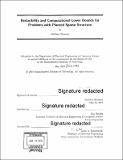| dc.contributor.advisor | Guy Bresler. | en_US |
| dc.contributor.author | Brennan, Matthew (Matthew Stewart) | en_US |
| dc.contributor.other | Massachusetts Institute of Technology. Department of Electrical Engineering and Computer Science. | en_US |
| dc.date.accessioned | 2018-09-17T15:55:49Z | |
| dc.date.available | 2018-09-17T15:55:49Z | |
| dc.date.copyright | 2018 | en_US |
| dc.date.issued | 2018 | en_US |
| dc.identifier.uri | http://hdl.handle.net/1721.1/118062 | |
| dc.description | Thesis: S.M. in Computer Science and Engineering, Massachusetts Institute of Technology, Department of Electrical Engineering and Computer Science, 2018. | en_US |
| dc.description | Cataloged from PDF version of thesis. | en_US |
| dc.description | Includes bibliographical references (pages 145-155). | en_US |
| dc.description.abstract | Recently, research in unsupervised learning has gravitated towards exploring statistical-computational gaps induced by sparsity. A line of work initiated by Berthet and Rigollet has aimed to explain these gaps through reductions to conjecturally hard problems from complexity theory. However, the delicate nature of average-case reductions has limited the development of techniques and often led to weaker hardness results that only apply to algorithms that are robust to different noise distributions or that do not need to know the parameters of the problem. We introduce several new techniques to give a web of average-case reductions showing strong computational lower bounds based on the planted clique conjecture for planted independent set, planted dense subgraph, biclustering, sparse rank-1 submatrix, sparse PCA and the subgraph stochastic block model. Our results demonstrate that, despite the delicate nature of average-case reductions, using natural problems as intermediates can often be beneficial, as is the case in worst-case complexity. Our main technical contribution is to introduce a set of techniques for average-case reductions that: (1) maintain the level of signal in an instance of a problem; (2) alter its planted structure; and (3) map two initial high-dimensional distributions simultaneously to two target distributions approximately under total variation. We also give algorithms matching our lower bounds and identify the information-theoretic limits of the models we consider. | en_US |
| dc.description.statementofresponsibility | by Matthew Brennan. | en_US |
| dc.format.extent | 155 pages | en_US |
| dc.language.iso | eng | en_US |
| dc.publisher | Massachusetts Institute of Technology | en_US |
| dc.rights | MIT theses are protected by copyright. They may be viewed, downloaded, or printed from this source but further reproduction or distribution in any format is prohibited without written permission. | en_US |
| dc.rights.uri | http://dspace.mit.edu/handle/1721.1/7582 | en_US |
| dc.subject | Electrical Engineering and Computer Science. | en_US |
| dc.title | Reducibility and computational lower bounds for problems with planted sparse structure | en_US |
| dc.type | Thesis | en_US |
| dc.description.degree | S.M. in Computer Science and Engineering | en_US |
| dc.contributor.department | Massachusetts Institute of Technology. Department of Electrical Engineering and Computer Science | |
| dc.identifier.oclc | 1051460504 | en_US |
